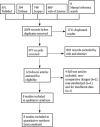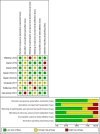How autologous platelet-rich plasma affects pregnancy and birth outcomes in women with repeated embryo implantation failure: A prisma-compliant meta-analysis
- PMID: 37260250
- PMCID: PMC10236229
- DOI: 10.4274/tjod.galenos.2023.46588
How autologous platelet-rich plasma affects pregnancy and birth outcomes in women with repeated embryo implantation failure: A prisma-compliant meta-analysis
Abstract
Repeated implantation failure refer to failure to conceive after three or more embryo transfer attempts. Several interventions were offered to improve maternal and fetal outcomes. Our objective was to investigate the impact of platelet-rich plasma (PRP) as a promising intervention to improve both pregnancy and birth outcomes. We searched PubMed, Scopus, Web of Science, and Cochrane Central, in addition to other relevant resources of grey literature. Only clinical trials were eligible to be included. We performed the meta-analysis using a random effects model. Eight randomized clinical trials, enrolling 1038 women with more than 3 implantation failure attempts, were included. We found a significant increase regarding all our prespecified primary outcomes. Chemical pregnancy rate [relative ratio (RR): 1.96, 95% confidence interval (CI): 1.61, 2.39; p<0.001], clinical pregnancy rate (RR: 4.35, 95% CI: 1.92, 2.88; p<0.001), and live birth rate (RR: 4.03, 95% CI: 1.29, 12.63; p=0.02) were found to be statistically significant and increased in patients who received PRP compared with the control group. Implantation rate (RR: 1.98, 95% CI: 1.34, 2.75; p<0.001), miscarriage rate (RR: 0.44, 95% CI: 0.23, 0.83, p=0.01), and multiple pregnancy rate (RR: 2.56, 95% CI: 1.02, 6.42, p=0.04) were also found to be significantly increased in the PRP group. We provide strong evidence on how intrauterine PRP can improve implantation, pregnancy, and birth outcomes in RIF women, which should direct clinicians to consider this intervention as a very effective tool in assisted reproductive techniques.
Keywords: Platelet-rich plasma; assisted reproductive techniques and in vitro fertilization; implantation failure.
©Copyright 2023 by Turkish Society of Obstetrics and Gynecology | Turkish Journal of Obstetrics and Gynecology published by Galenos Publishing House.
Conflict of interest statement
Conflict of Interest: No conflict of interest was declared by the authors.
Figures









Similar articles
-
Effect of intrauterine infusion of platelet-rich plasma for women with recurrent implantation failure: a systematic review and meta-analysis.J Obstet Gynaecol. 2023 Dec;43(1):2144177. doi: 10.1080/01443615.2022.2144177. Epub 2022 Nov 17. J Obstet Gynaecol. 2023. PMID: 36397660
-
Intrauterine infusion of autologous platelet-rich plasma in women undergoing assisted reproduction: A systematic review and meta-analysis.J Reprod Immunol. 2020 Feb;137:103078. doi: 10.1016/j.jri.2019.103078. Epub 2019 Dec 31. J Reprod Immunol. 2020. PMID: 32006776
-
The efficacy of intrauterine infusion of platelet rich plasma in women undergoing assisted reproduction: a systematic review and meta-analysis.BMC Pregnancy Childbirth. 2023 Dec 8;23(1):843. doi: 10.1186/s12884-023-06140-0. BMC Pregnancy Childbirth. 2023. PMID: 38066425 Free PMC article.
-
Autologous platelet-rich plasma intrauterine perfusion to improve pregnancy outcomes after implantation failure: A systematic review and meta-analysis.J Obstet Gynaecol Res. 2022 Dec;48(12):3137-3151. doi: 10.1111/jog.15431. Epub 2022 Sep 14. J Obstet Gynaecol Res. 2022. PMID: 36104948
-
Effects of Intrauterine Infusion of Autologous Platelet-Rich Plasma in Women Undergoing Treatment with Assisted Reproductive Technology: a Meta-Analysis of Randomized Controlled Trials.Geburtshilfe Frauenheilkd. 2022 Dec 13;83(4):453-462. doi: 10.1055/a-1963-7459. eCollection 2023 Apr. Geburtshilfe Frauenheilkd. 2022. PMID: 37034414 Free PMC article.
Cited by
-
Platelet-Rich Plasma With an Activator: A New Approach for Treating Thin Endometriums of Women Suffering From Infertility.Cureus. 2024 Sep 30;16(9):e70495. doi: 10.7759/cureus.70495. eCollection 2024 Sep. Cureus. 2024. PMID: 39479074 Free PMC article.
-
Platelet-Rich Plasma (PRP) for Endometrial Treatment Efficacy and Safety in Assisted Reproductive Technology: A Comprehensive Review.Cureus. 2024 May 6;16(5):e59728. doi: 10.7759/cureus.59728. eCollection 2024 May. Cureus. 2024. PMID: 38841044 Free PMC article. Review.
-
Platelet rich plasma for assisted reproduction: an overview of systematic reviews.Blood Transfus. 2025 Jul-Aug;23(4):322-337. doi: 10.2450/BloodTransfus.937. Epub 2025 Apr 15. Blood Transfus. 2025. PMID: 40423588 Free PMC article.
-
A Successful Pregnancy Outcome Using Laser-Assisted Hatching and Platelet-Rich Plasma Perfusion in Advanced Maternal and Paternal Age: A Case Report.Cureus. 2024 Jul 5;16(7):e63926. doi: 10.7759/cureus.63926. eCollection 2024 Jul. Cureus. 2024. PMID: 39105032 Free PMC article.
-
Study Protocol: Evaluating the Effect of Autologous Platelet-Rich Plasma Infusion in the Endometrial Cavity for Enhanced Embryo-Endometrium Synchrony in Patients with Repeated Implantation Failure.J Pharm Bioallied Sci. 2025 May;17(Suppl 1):S897-S900. doi: 10.4103/jpbs.jpbs_260_25. Epub 2025 Apr 21. J Pharm Bioallied Sci. 2025. PMID: 40510993 Free PMC article.
References
-
- Groenewoud ER, Cantineau AEP, Kollen BJ, Macklon NS, Cohlen BJ. What is the optimal means of preparing the endometrium in frozen-thawed embryo transfer cycles? A systematic review and meta-analysis. Hum Reprod Update. 2013;19:458–70. - PubMed
-
- El-Toukhy T, Coomarasamy A, Khairy M, Sunkara K, Seed P, Khalaf Y, et al. The relationship between endometrial thickness and outcome of medicated frozen embryo replacement cycles. Fertil Steril. 2008;89:832–9. - PubMed
-
- Magdi Y, El-Damen A, Fathi AM, Abdelaziz AM, Abd-Elfatah Youssef M, Abd-Allah AA-E, et al. Revisiting the management of recurrent implantation failure through freeze-all policy. Fertil Steril. 2017;108:72–7. - PubMed
-
- Lédée-Bataille N, Olivennes F, Lefaix JL, Chaouat G, Frydman R, Delanian S. Combined treatment by pentoxifylline and tocopherol for recipient women with a thin endometrium enrolled in an oocyte donation programme. Hum Reprod. 2002;17:1249–53. - PubMed
-
- Barad DH, Yu Y, Kushnir VA, Shohat-Tal A, Lazzaroni E, Lee H-J, et al. A randomized clinical trial of endometrial perfusion with granulocyte colony-stimulating factor in in vitro fertilization cycles: impact on endometrial thickness and clinical pregnancy rates. Fertil Steril. 2014;101:710–5. - PubMed
LinkOut - more resources
Full Text Sources
Research Materials
